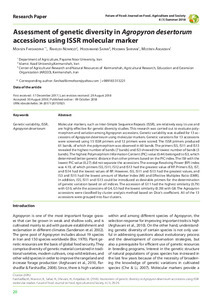Aufsatz

Assessment of genetic diversity in Agropyron desertorum accessions using ISSR molecular marker
Zusammenfassung
Molecular markers, such as Inter-Simple Sequence Repeats (ISSR), are relatively easy to use and are highly effective for genetic diversity studies. This research was carried out to evaluate polymorphism and variation among Agropyron accessions. Genetic variability was studied for 13 accessions of Agropyron desertorum using molecular markers. Genetic variations for 13 accessions were screened using 15 ISSR primers and 12 primers were scored. The ISSR primers produced 61 bands, of which the polymorphism was observed in 60 bands. The primers IS5, IS11 and IS13 revealed the highest number of bands (7 bands) and IS3 showed the lowest number of bands (3 bands). The highest Polymorphism Information Content (PIC) value (0.44) belonged to IS3, which determined better genetic distance than other primers based on the PIC index. The IS9 with the lowest PIC value (0.27) did not separate the accessions. The average Resolving Power (RP) index was 4.19, of which primers IS5, IS11, IS12 and IS13 had the greatest value of RP. Primers IS3, IS7, and IS14 had the lowest values of RP. However, IS5, IS11 and IS13 had the greatest values, and IS3 and IS15 had the lowest amount of Marker Index (MI) and Effective Multiplex Ratio (EMR). In addition, IS5, IS11 and IS13 could be introduced as desirable primers for the determination of genetic variation based on all indices. The accession of G11 had the highest similarity (0.79) with G10, while the accessions of G4, G5 had the lowest similarity (0.39) with G8. The Agropyron accessions were classified by cluster analysis method based on Dice's coefficient. All of the 13 accessions were grouped into four clusters.
Zitierform
In: Future of Food: Journal on Food, Agriculture and Society. Witzenhausen : University of Kassel, Specialized Partnerships in Sustainable Food Systems and Food Sovereignty. - Vol. 6, No. 1 (2018), S. 20-29Sammlung(en)
Vol 06, No 1 (2018) (Future of Food: Journal on Food, Agriculture & Society // The Future of Food Journal: Journal on Food, Agriculture & Society)Zitieren
@article{urn:nbn:de:hebis:34-2017120753925,
author={Farshadfar, Mohsen and Nowrozi, Raheleh and Safari, Hooshmand and Shirvani, Hooman and Amjadian, Mostafa},
title={Assessment of genetic diversity in Agropyron desertorum accessions using ISSR molecular marker},
year={2018}
}
0500 Oax 0501 Text $btxt$2rdacontent 0502 Computermedien $bc$2rdacarrier 1100 2018$n2018 1500 1/eng 2050 ##0##urn:nbn:de:hebis:34-2017120753925 3000 Farshadfar, Mohsen 3010 Nowrozi, Raheleh 3010 Safari, Hooshmand 3010 Shirvani, Hooman 3010 Amjadian, Mostafa 4000 Assessment of genetic diversity in Agropyron desertorum accessions using ISSR molecular marker / Farshadfar, Mohsen 4030 4060 Online-Ressource 4085 ##0##=u http://nbn-resolving.de/urn:nbn:de:hebis:34-2017120753925=x R 4204 \$dAufsatz 4170 7136 ##0##urn:nbn:de:hebis:34-2017120753925
<resource xsi:schemaLocation="http://datacite.org/schema/kernel-2.2 http://schema.datacite.org/meta/kernel-2.2/metadata.xsd"> 2018-10-16T11:53:25Z 2018-10-16T11:53:25Z 2018-10-09 2197-411X urn:nbn:de:hebis:34-2017120753925 http://hdl.handle.net/123456789/2017120753925 eng Section Specialized Partnerships in Sustainable Food Systems and Food Sovereignty at the University of Kassel, Germany and Federation of German Scientists (VDW) Urheberrechtlich geschützt https://rightsstatements.org/page/InC/1.0/ Genetic variability ISSR Agropyron desertorum 630 Assessment of genetic diversity in Agropyron desertorum accessions using ISSR molecular marker Aufsatz Molecular markers, such as Inter-Simple Sequence Repeats (ISSR), are relatively easy to use and are highly effective for genetic diversity studies. This research was carried out to evaluate polymorphism and variation among Agropyron accessions. Genetic variability was studied for 13 accessions of Agropyron desertorum using molecular markers. Genetic variations for 13 accessions were screened using 15 ISSR primers and 12 primers were scored. The ISSR primers produced 61 bands, of which the polymorphism was observed in 60 bands. The primers IS5, IS11 and IS13 revealed the highest number of bands (7 bands) and IS3 showed the lowest number of bands (3 bands). The highest Polymorphism Information Content (PIC) value (0.44) belonged to IS3, which determined better genetic distance than other primers based on the PIC index. The IS9 with the lowest PIC value (0.27) did not separate the accessions. The average Resolving Power (RP) index was 4.19, of which primers IS5, IS11, IS12 and IS13 had the greatest value of RP. Primers IS3, IS7, and IS14 had the lowest values of RP. However, IS5, IS11 and IS13 had the greatest values, and IS3 and IS15 had the lowest amount of Marker Index (MI) and Effective Multiplex Ratio (EMR). In addition, IS5, IS11 and IS13 could be introduced as desirable primers for the determination of genetic variation based on all indices. The accession of G11 had the highest similarity (0.79) with G10, while the accessions of G4, G5 had the lowest similarity (0.39) with G8. The Agropyron accessions were classified by cluster analysis method based on Dice's coefficient. All of the 13 accessions were grouped into four clusters. open access In: Future of Food: Journal on Food, Agriculture and Society. Witzenhausen : University of Kassel, Specialized Partnerships in Sustainable Food Systems and Food Sovereignty. - Vol. 6, No. 1 (2018), S. 20-29 Farshadfar, Mohsen Nowrozi, Raheleh Safari, Hooshmand Shirvani, Hooman Amjadian, Mostafa </resource>
Die folgenden Lizenzbestimmungen sind mit dieser Ressource verbunden:
Urheberrechtlich geschützt

